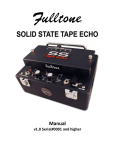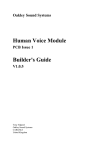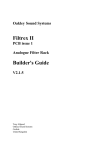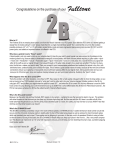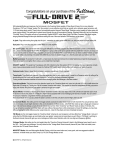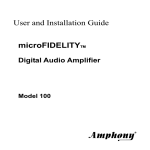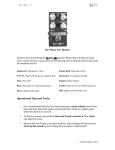Download ABY-ST - Fulltone
Transcript
ABY-ST Owner’s Manual In my studio, there are 20-30 some-odd vintage amps: from a 1959 Bassman, to a 1959 Fawn-colored Vox AC15, to the entire 60’s Fender Blackface line in duplicate, to every year of Marshall 50 & 100 watt amp spanning 1966 through 1971. I was always a single-amp live-performer until I heard/saw Eric Johnson in the mid 80’s while he was doing a set for Fender at the NAMM show. Eric ripped that evening, but what most impressed me was his constant switching between the bell-like OD-friendly Fender tones and the huge, warm, and fuzz-friendly vintage Marshalls...sounding like 2 guitarists in the process. At soundcheck, Eric was nice enough to explain his setup to this curious 23 year old who was so blown away by the high-volume sounds being created that my life was changed that very day. I immediately set out to expand my own tonal palette by switching and combining 2 or 3 amps in my own Jazz/Rock/Blues music, and started immersing myself in effect and amp design, repair, and modification, eventually leading to this little thing we like to call “Fulltone.” I designed the True-Path ABY switchers to solve all of the issues that arise from combining amplifiers, and to sound absolutely transparent in the process. Other ABY’s “thump” when switching, Yes, even if they advertise that they don’t! I developed a circuit that rapidly pans between the outputs, completely eliminating “thumps.” On this subject: Especially when using single coil pickups, lights and stray electro-magnetic-fields (EMF’s) can appear to be a slight “ticking” noise, but this is simply those noises coming through your pickups and cutting on and off as the signal pans between the outputs. To test this, simply turn off your Guitar’s volume knob and hear that our ABY is dead-quiet. “ST” stands for “Soft Touch,” meaning it has smooth-actuating, non-latching, momentary footswitches that are absolutely quiet for studio and/or live applications, where even the click of a footswitch could get you noticed in the wrong way. The ABY-ST allows you to create many amazing sounds not possible with a single-amp set-up! Play on! Michael Fuller/President This unit is ONLY to be used to switch between or combine UL (or CSA) listed, properly-grounded amplifiers, and only connecting to the amp’s INPUT. This product should never be connected to the SPEAKER OUT of an amplifier or you will damage this pedal and the amp(s) involved. There is always danger of electrocution when combining amplifiers, if you have any questions please contact a qualified technician. Use this product at your own risk, Fulltone is not responsible for any loss, damage, or injury resulting from the use (or misuse) of this product. True-Path ABY has an isolation transformer on the B-Out that may aid in certain pedalboard-related grounding issues. Your True-Path ABY also offers the ability to “lift” the ground on the B-Out although we cannot recommend lifting grounds for legal and safety reasons. Again, contact a qualified technician if you have questions and be safe! Specifications: Current draw= 100ma. Compatible with most Pro pedalboard power supplies. Make sure to use a “regulated” power supply! Size= 5.25”W x 4.0”D x 1.8”H Weight= 1lb 7 oz. Housing= 16 gauge steel Buffer Specifications: This ABY contains 2 high-headroom, high-quality JFET buffers. Input Impedance= 1.1 megaohms...very high, optimal for guitar pickups. Buffer Output Impedance= 100 ohms...extremely low so as not to load down your guitar cables or other pedals in your signal chain. Transformer: Fulltone custom-wound 1:1 Isolation transformer, high Nickel core content, the best sounding transformer you can get, period. Primary Impedance= 10K ohms Secondary impedance= 10K ohms © 2013 FMP Inc. All Rights Reserved 7 8 4 6 12 11 10 9 5 3 1 2 Input: (see #9 on above diagrams) Connect a cable (shielded with ¼” mono plugs) coming from your guitar, bass, or other instrument into this jack. Always use good quality shielded cables (eg.Fulltone Gold Standards) for audio signals, speaker cables are un-shielded and should not ever be used to connect your instrument. A-Out: (#12) Connect a cable (shielded with ¼” mono plugs) going to your amplifier. A-Out does not have a transformer on it. It does have a switchable Buffer. B-Out: (#11) Connect a cable (shielded with ¼” mono plugs) going to your amplifier. B-Out has a 1:1 transformer that is always in the signal path. This transformer is Fulltone custom-wound designed to reduce shock hazard when running multiple amps. B-Out also has a switchable Buffer. True-Path ABY’s do not have a “Tuner-Out” on its ABY’s because quite simply they introduce a clicking sound (from the Tuner) to the audio path that we find unacceptable. A or B footswitch: (see #1) Press this to send the signal to either A-Out or B-Out. When the Yellow L.E.D (#3) is lit, signal only flows to A-Out. When the Green L.E.D (#4) is lit, signal only flows to B-Out. Both footswitch: (#2) Press this to have both the signal flow to A-Out and B-Out simultaneously. Can be done whether you are on channel A or channel B. Channel-A Buffer switch: (#5) Turns ON or OFF a high-quality JFET Buffer circuit affecting only the A-Out. A buffer is helpful because it can drive the longer cable lengths which you have if you’re using a pedalboard with multiple pedals, multiple pedal connecting cables, and instrument cables with a combined total of 25 or more feet. Without a buffer you will experience Treble loss as well as overall signal level loss, meaning that your amp won’t respond to your touch like it would plugging the guitar straight in with just a 10 foot cable. The downside to a buffer is that certain Fuzz pedals do not react well to the buffer’s low-impedance signal. That’s why the buffer feature is defeatable on the True-Path ABY. Channel-B Buffer switch: (#6) Turns ON or OFF a second high-quality JFET Buffer circuit affecting only the B-Out. This buffer is also defeatable. Ground-Lift for B-Out: (#7) The default setting for this switch is “Grounded.” It offers the ability to “lift” the ground on the B-Out although we cannot recommend lifting grounds for safety and legal reasons. When this switch is set to “lifted,” there can sometimes be less hum in the amp connected to the B-Out. Phase switch for B-Out: (#8) This switch corrects phase issues between 2 amps. Phase is the relationship between 2 different sound waves, and amps can often be “out of phase” with each other resulting in weak sound when combining the amps using the Both footswitch. To check phase, position the 2 amps directly in front of you (about 6 or more feet apart) both equal distance from the wall. Turning the amps on, select the Both switch and start moving the Phase switch from (+) to (-) while letting a chord ring out. If the bass drops and sound appears to be coming entirely from far left and right with no center content on one switch setting...your amps are “out of phase” and the Phase switch should be set to the opposite direction. The correct setting for the True-Path Phase switch varies between amps and even between amp channels, for example Blackface Fenders, so always check the phase relationship between your amps before the gig. DC Power Port: (#10) You may ONLY run this device on a high-quality regulated 9VDC wallwart (included) or high-quality 9VDC regulated pedalboard powersupply. The tip must be configured as the (industry-standard) 2.1mm x 5.5mm barrel plug with “Negative to Center Pin” configuration, as per following diagram. A battery cannot be used because the current draw is far too high and the pedal’s performance is dependent on the unit getting clean, accurate 9.0 volts, hence the need for a regulated power source. The True-Path ABY has a protective circuit that can withstand short durations of over-voltage but never try and operate this device on 12, 18 or any other voltage than 9VDC. The Fulltone FPS-1 (included) is a great 9VDC regulated wall wart adapter. As far as pedalboard power supplies, we have always recommended ours (when available) and the Voodoo Lab products. There are some bad power supplies being sold as “professional product.” If a multi-out power supply is not advertised as having “discrete” outputs and is not “regulated” then don’t buy it as it will simply offer you noise and may damage many of your pedals in the long run. Warranty: Fulltone products carry a Limited 5 year Warranty to the original owner with proof of purchase that the product was bought from an Authorized Fulltone Dealer. There is no need to register your product, simply keep a copy of your original sales receipt. The Warranty covers failure due to manufacturing errors only and is void if any mod or repair is performed by anyone other than Fulltone AND/OR if we deem that any operator-caused abuse or damage has occurred, for example; the use of an incorrect power supply, a dropped pedal, water damage, etc. Customer is always responsible for all shipping costs both to and from Fulltone. Do not attempt to call Fulltone, instead, all Repair issues are handled via email to troubleshoot the possible problem and (after troubleshooting) for the scheduling of Warranty Repair. After we have deemed that a repair is necessary, we will email you an Acrobat PDF copy of our Return Authorization Form (RA Form) and print it out, fill out all information, and include it with the device you are sending. Fulltone Musical Products Inc. is not responsible for and injuries and/or damages related to the use of our products. © 2013 FMP Inc. All Rights Reserved Fulltone Musical Products Inc. 11018 Washington Blvd. Culver City, CA 90232 for more info and expanded information & videos go to www.fulltone.com Sales related questions email [email protected] Repairs/Technical related questions email [email protected]


